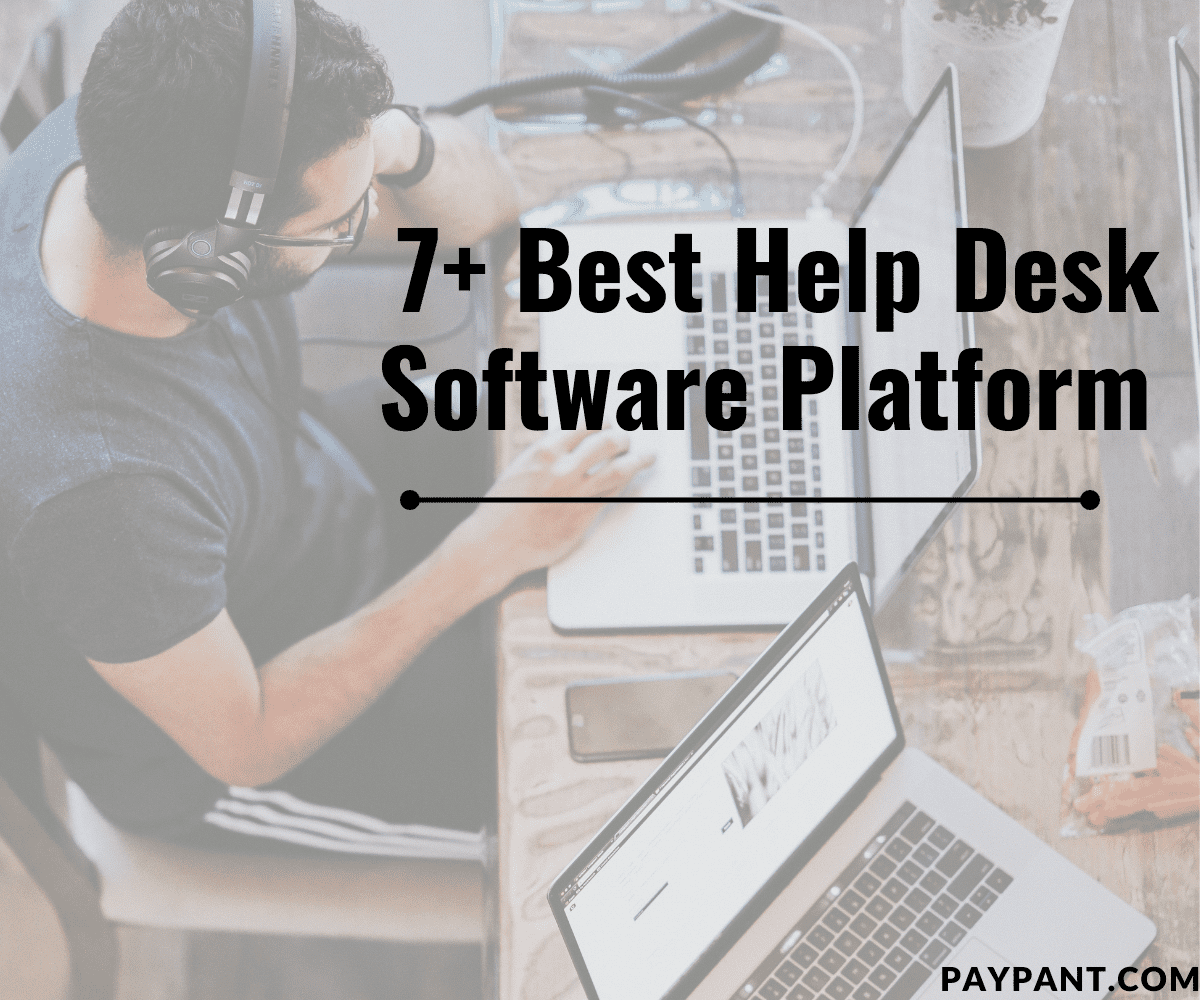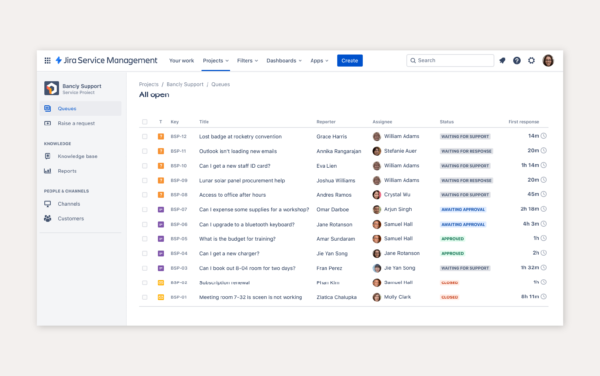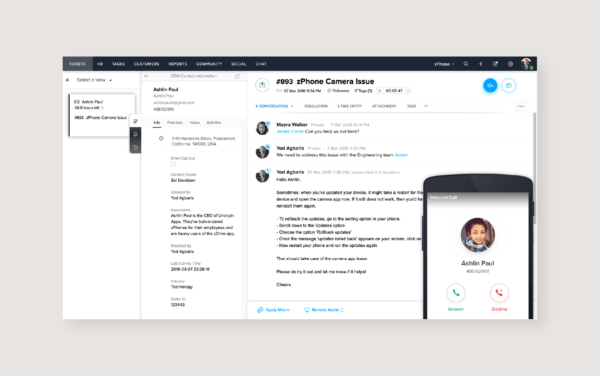7+ Best Help Desk Software Platform

7+ Best Help Desk Software Platform
As clients use more platforms to contact your company, it is critical to implement help desk software that successfully maintains your customer relationship. Help desk and ticketing software are essential to modern business operations.
Third-party connectors with other critical corporate software platforms, particularly CRM software, will be available in the finest help desk software.
Furthermore, the incorporation of analytics into help desk systems makes them ideal for assessing key performance indicators (KPIs) and assisting in improving overall efficiency and productivity.
Help desk software isn't just for staff ticketing; it may also be utilized for front-facing customer assistance concerns.
The recent pandemic has highlighted this, with firms shifting customer support systems online rather than depending on phone call centers.
However, searching for "Help Desk Software Platform" online would provide hundreds, if not thousands, of results. So how do you sort through all of them to select the best?
Finding the finest help desk and ticketing software for you can be difficult with so many options available. The top available help desk software, features, pricing, and other factors will be highlighted below.
What Is Help Desk Software?

Help desk software is a tool for organizing, managing, and responding to support inquiries. Some help desks handle external client requests, while others handle internal service requests from team employees.
Help desk software is a product used by customer service units and IT teams to help firms streamline their customer relationship management process.
You can use this program to automate manual activities and do them more quickly.
Because it consolidates all of your customer support interactions into one omnichannel tool, using a help desk platform is a great way to improve your customer experience.
75% of customers want a consistent experience regardless of how they engage a company (via social media, in person, by phone, etc.).
A help desk may feature a shared mailbox, knowledge base software, and a live chat solution, among other things. However, not all help desks have all of the tools listed above.
Good Read: 7 Best Lead Generation Software (to Get More Leads)
How Does A Help Desk Software Work?

Assume a customer emails you or contacts you on social media. What will happen next is as follows:
- Your help desk tool will record The incoming query as a ticket.
- Each ticket is classified, prioritized, and given to a support representative. (You can automate these operations by setting up automation rules in your help desk software, or you may do it manually.)
- From the help desk software, the agent will view the ticket, gather context from any previous encounters, and respond.
- The agent's response will then be forwarded to the customer via the channel through which the ticket was raised.
Why Use Help Desk Software?
To better serve your customers, help desk software makes it simple to manage customer support queries.
This results in happier customers and more customer retention, which means more money for your company in the long run.
When you're first starting out online, it can be tempting to handle all of your customer service requests yourself using your business email address.
However, when your company grows, it might not be easy to maintain the same level of customer service.
Using help desk software in your organization can improve the quality of your client interactions and provide you with a competitive advantage.
Types of Help Desk Software
1. Cloud-based
The software supplier hosts cloud-based help desk software, which is accessed via the Internet. It supports easy scaling and offers automatic updates and backups. To use the tool, you must first log in to the website or application and pay a monthly or yearly charge.
2. Self-hosted
Self-hosted help desk software is deployed on a company's own servers, providing greater control over data and security.
However, it necessitates more upkeep and is less versatile than cloud-based choices. It could be something you make yourself or something you buy from another company. It is proprietary software, just like cloud-based.
3. Open source
Open-source help desk software is free and configurable, allowing organizations to tailor it to their own requirements. It is, however, more complex to set up and requires technical competence.
Though the following factors may be considered when purchasing an external solution, purchasing an external one will almost always be cloud-based (all options listed below are cloud-based).
There may be times when you purchase a solution that is placed directly on your own servers, but this is not very frequent or viable for most teams due to the cost of the installation and maintenance of the program.
Another — and possibly more relevant — way to consider help desk software categorization is in terms of who you're using it to service. In that situation, there are two types: internal and external.
4. Internal/IT Service Desk
An internal help desk solution is often employed to manage IT-related difficulties. Employees can submit tickets to your IT team directly, making handling and organizing those requests easier.
This program is specifically developed to handle IT services within a corporation. It typically encompasses incident management, problem management, change and release management, and asset management.
Its goal is to provide a single point of contact for any IT-related issues.
5. Ticketing help desk software
This is a system that handles and tracks customer support requests, also known as 'tickets.'
It manages the whole ticket lifecycle, from creation to resolution, to guarantee that every customer issue is effectively addressed and nothing falls between the cracks.
6. Customer Support
Customer support teams typically utilize customer-facing help desk software to manage incoming client contacts.
The functionality of these applications varies, but most feature a shared inbox and some type of collaboration, productivity, and reporting tools.
7. On-premise help desk software
Instead of cloud-based options, self-hosted or on-premise help desk software is stored locally on your company's server.
The most significant advantage of adopting an on-premise support desk system is that you have complete control over where data is stored, ensuring that security is never compromised.
However, most cloud-based help desk software now adheres to international security standards, including HIPAA and GDPR regulations.
Furthermore, changing an on-premise help desk system can be time-consuming, and you may suffer frequent downtimes for updates or maintenance.
8. Enterprise
Enterprise help desk software is designed for larger organizations with more complex needs, such as multiple departments and teams.
It frequently contains complex capabilities such as asset management and compliance with the IT Infrastructure Library (ITIL).
7+ Best Help Desk Platform
1. JIRA

JIRA enables a rapid flow of information among teams, allowing for the rapid detection of events when they occur.
Jira service desk is an assistance and project management software created in 2013.
However, to enable teams to provide a more extraordinary service experience, JIRA launched the JIRA service management software, which performs all of the advanced features of a JIRA's help desk and more.
Jira Service Desk is commonly linked with engineering teams, but many support teams also use it as a location to submit and monitor defects.
Users can design custom processes and forms to ensure projects operate well, and they can assign statuses to specific tasks to keep everyone informed.
Reports can provide support representatives with insights into what's being worked on and the overall workload, providing more context to bug-tracking and requests.
So, if you want a help desk software that also serves as a sophisticated IT service management solution, use JIRA.
Key Features of JIRA
- Request Management: This feature enables you to fulfill thousands of customer requests through automation. It also enables you to customize request-type forms.
- Incident Management: JIRA allows for a fast flow of information among teams to enable the fast detection of incidents when they occur.
- This feature comes with an incident swarming and on-call alerting functionality to enable the smooth resolution of issues.
- Problem Management: This feature detects problems and shows them to you in their order of priority. First, it identifies issues with great potential of causing major damage to your customer service activities, and then it gives you detailed analytics of the root cause of it.
- This feature also has a problem reporting functionality that gives you an overview of recurring, new, and the number of same-type issues.
- Change Management: In the case where a change occurs in your workflow process, JIRA allows you to manage these changes better.
- It also allows you to integrate CI/CD tools and Confluence – tools that allow for effective change management.
- Asset Management: With this feature, you can manage assets, track assets, discover assets, review assets, and migrate or federate assets.
- Configuration Management: this feature gives you an insight into the infrastructure that supports a service or application. It shows you the later-stage effect of a change to enable you to anticipate risks.
- Knowledge Management: This feature thrives on reducing the number of requests your team receives by enabling a knowledge base section and online forums where your team members can post how-to articles, FAQs, and more.
- Queues: This feature presents the customer's request in a queue format to give you a clear vision of what should be prioritized.
- SLA management: This feature enables you to set and manage goals for managing customer issues. With SLA, you can set and track goals like "respond to all requests within two hours."
- Analytics & Reporting: This feature enables you to view the progress and status of the activities carried out by your team.
- Apps and Integration: JIRA has an app market where you can get apps to integrate with the JIRA service desk.
You can also integrate customer relationship management software (CRM) with the JIRA service desk.
Pros:
- Seamlessly integrates with other Atlassian products.
- It's suitable for both small teams and large enterprises.
- You can track support requests and tickets in real-time.
- Its features facilitate effective team collaboration.
- It has a strong emphasis on aligning IT teams with other departments.
Cons:
- Can be complex and might require a learning curve for new users.
- The cost can add up for larger teams.
JIRA Pricing Plan
JIRA has a four-pricing plan which includes a free forever plan. The standard plan costs $20 per agent, and the Premium plan costs $45 per agent.
The Enterprise plan is quotation-based.
2. Zendesk Support

Zendesk Support is widely renowned for having the greatest ticketing system, which allows you to provide excellent customer service. It is also one of the best marketing automation software.
Almost everyone who works in customer service has heard of Zendesk. They create a multi-channel support system with features such as a shared inbox, a knowledge base, and live chat tools.
In addition, they provide more complex AI-based solutions for chatbots and autoresponders (albeit these are only available on their more expensive plans).
You also get a slew of productivity and automation tools and over 1,000+ integrations to connect with other technologies in your support ecosystem.
To be honest, there isn't much Zendesk doesn't do or communication methods it doesn't support.
However, it is a complex and complicated product that demands significant time, work, and resources to get up and operate.
This adds significant additional expenditures on top of the monthly charge. This is because most teams don't require access to all of the capabilities Zendesk provides (do you really need to run those community forums? ), so it's extremely conceivable they could find a solution that meets their needs for less money.
Key Features of Zendesk Support
- Live chat and messaging: With Zendesk, you can offer one-on-one customer experience to your customers.
- The live chat feature allows customers to communicate with your team and send requests while surfing through your site or app.
- The messaging feature contains typing indicators, read receipts, and chat group functionality.
- Custom views: This feature streamlines your ticket management process by enabling you to group tickets into lists or queues. This feature also gives you complete control over how you view tickets.
- Self-service option: This feature reduces the volume of tickets your team receives by providing a self-service solution for customers to get the help they need.
- The self-service options Zendesk provides include a Knowledge base or help center, community forums, customer portal, FAQs pages, and more.
- Integrated voice software: You can resolve complex customer issues by integrating your favorite call center solution into Zendesk and using it to communicate directly with customers.
- Analytics and Reporting: This feature measures customer interaction with your team and gives you a performance report through charts.
- Collaboration tools: Zendesk makes it easier for your internal and external team to collaborate on tasks by providing tools such as Side conversations, Skills-based Routing, Connect, Light agents, and more.
- API, SDKs, and app integration: Zendesk App Marketplace lets you integrate your preferred apps with Zendesk help desk software.
- Automated Routing: This feature gathers your customer information and then uses it to ensure the customer request gets to the right agent to resolve it.
- Custom Branding: This feature enables you to brand your help center and your agent interface.
- Omnichannel Support: With this feature, you can offer a stellar customer experience across multiple communication channels while remaining consistent.
Pros:
- Enables handling of customer interactions across multiple platforms.
- Streamlines support with automated routine tasks.
- Efficiently routes tickets to the appropriate service representative.
- Allows users to find solutions via self-help knowledge bases.
- Provides comprehensive insights into service operations.
Cons:
- Can be pricey, especially for small businesses.
- Requires time to understand and use its full feature set.
- Its customization options may be insufficient for unique service needs.
Zendesk Support Pricing Plan
Zendesk Support offers three pricing plans with a 30-day free trial period.
- The Support Team plan costs $19/month per agent.
- The Support Professional plan costs $49/month per agent.
- The Support Enterprise plan costs $99/month per agent.
3. Zoho Desk

Zoho Desk is one of the services provided by Zoho, including being one of the best accounting software for business. This solution includes a help desk ticketing function that optimizes your team's customer care activities.
You may be familiar with Zoho as a customer relationship management tool, but they also provide a customer support solution.
Zoho Desk contains many of the expected features, such as a shared mailbox and a knowledge base tool.
They also provide more advanced services such as AI-assisted response and complex automation for discussion sorting and tagging.
Zoho Desk connects effortlessly if you already use other Zoho products, such as the CRM tool.
However, their most complex and fundamental capabilities, like live chat, are only available on their most expensive corporate plan, which may be out of reach for certain teams.
Key Features of Zoho Desk
- Ticket Management: Zoho's ticketing software enables you to manage customer issues however they reach out to you.
It also enables you to assign tickets, collaborate with multiple teams when resolving issues, automate processes, and detect anomalies.
- SLAs & Escalations: Zoho's Service Level Agreements (SLAs) enable you to set ticket time goals. It also gives you an insight into the status of a ticket, the channel the ticket came from, and tickets that needs to be prioritized. With Zoho, you can set rules on when a ticket is due for escalation.
- Customer Happiness Rating: This feature allows your customer to reveal their thoughts on the customer service you offer and gives you an insight into your team's performance.
- Scheduled Reports: Aside from providing you with a Report and Analytics feature, Zoho also allows you to send reports to internal and external team members and Non-Zoho users. You can also schedule how often the reports are sent.
https://paypant.com/7-best-help-desk-software-platform/
Comments
Post a Comment